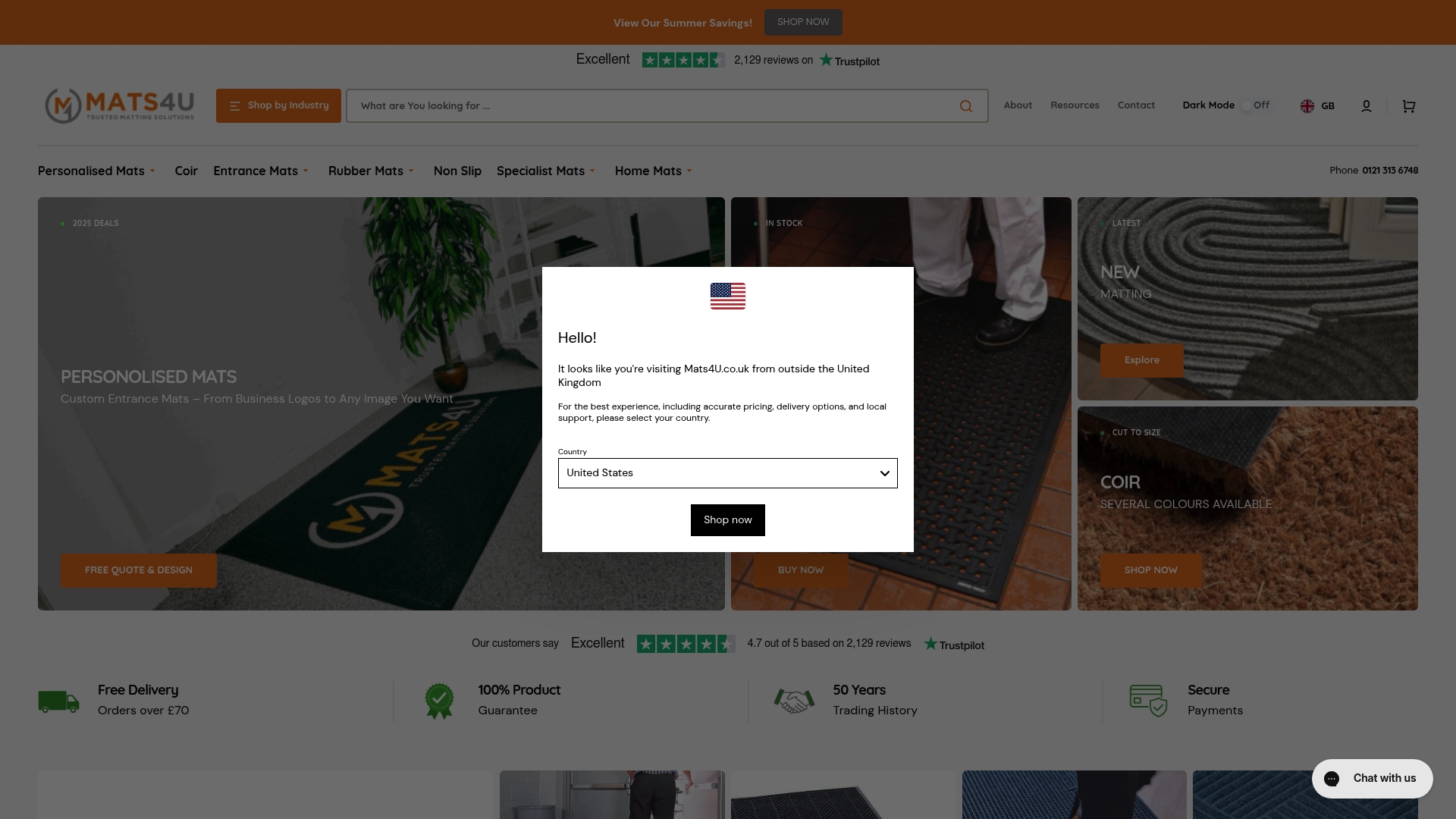Slippery floors in wet areas are a hidden hazard for any business or public space. Every year, slips and trips account for a striking percentage of workplace accidents in the UK according to the Health and Safety Executive. Most people think putting any mat down solves the problem. Actually, the design and material of anti slip mats make all the difference between a safe walkway and a costly accident.
Table of Contents
- Understanding The Importance Of Anti Slip Mats
- Key Features To Look For In Anti Slip Mats
- Best Materials For Wet Area Anti Slip Mats
- How To Properly Install Anti Slip Mats
- Maintaining Your Anti Slip Mats For Longevity
- Customisation Options For Businesses And Facilities
- Real-World Applications Of Anti Slip Mats
Quick Summary
| Takeaway | Explanation |
|---|---|
| Anti slip mats enhance safety in wet areas. | These mats significantly reduce the risk of slips, protecting employees and visitors from potential injuries. |
| Key features include durability and drainage. | Selecting mats should focus on resilient materials and effective liquid drainage to prevent slip hazards effectively. |
| Material selection impacts mat longevity and effectiveness. | High-performance synthetics, such as nitrile rubber and PVC, provide essential chemical resistance and durability for wet environments. |
| Proper installation is critical for effectiveness. | Ensure mats are securely fixed and properly sized to prevent edge lifting, which can increase slip risks. |
| Regular maintenance extends mat lifespan significantly. | Implement routine cleaning and inspections to keep mats functional and free from contaminants that can compromise safety. |
1: Understanding the Importance of Anti Slip Mats
Wet areas present significant safety challenges across various environments, from commercial kitchens and industrial workspaces to healthcare facilities and public spaces. Anti slip mats for wet areas are critical safety solutions designed to mitigate the risks associated with slippery surfaces, preventing potential accidents and injuries.
Statistics reveal the stark reality of slip and fall incidents. Research from the Health and Safety Executive indicates that slips and trips account for a substantial percentage of workplace accidents in the United Kingdom, making floor safety a paramount concern for organisations across different sectors.
Understanding the core importance of anti slip mats involves recognising their multifaceted protective capabilities. These specialised floor coverings offer comprehensive safety benefits:
-
Significantly reduce the risk of workplace accidents
-
Provide immediate traction on wet and potentially hazardous surfaces
-
Protect employees and visitors from potential injury and associated legal liabilities
Moreover, anti slip mats are not merely functional safety equipment but strategic investments in workplace risk management. Our guide on understanding outdoor mats for wet areas provides additional insights into selecting appropriate matting solutions for diverse environments.
The design and material composition of these mats make them highly effective in channelling water away from walking surfaces, creating a barrier between potentially slippery floors and pedestrian traffic. Engineered with advanced grip technologies, these mats incorporate specialised surface textures and drainage channels that actively disperse liquid, minimising slip hazards.
For businesses and institutions, implementing anti slip mats represents a proactive approach to safety management. Beyond preventing accidents, these mats demonstrate an organisation’s commitment to creating secure, responsible environments that prioritise human wellbeing.
Understanding the importance of anti slip mats goes beyond recognising their immediate safety function. They are strategic investments in risk mitigation, employee protection, and organisational responsibility.
2: Key Features to Look for in Anti Slip Mats
Selecting the right anti slip mats for wet areas requires careful consideration of several critical features that determine their effectiveness and performance. Material composition, surface texture, and drainage capabilities are paramount when evaluating these essential safety solutions.
Research from the National Floor Safety Institute highlights that proper mat selection can significantly reduce slip and fall incidents by up to 90% in commercial environments.
When assessing anti slip mats for wet areas, professionals should focus on the following key characteristics:
-
Durability and resistance to wear in high traffic zones
-
Effective liquid drainage and quick drying capabilities
-
Compatibility with multiple surface types and environmental conditions
Surface texture plays a crucial role in preventing slip hazards. Mats should incorporate raised patterns or microscopically engineered surfaces that create immediate traction, even when exposed to water, oils, or other liquids. Our comprehensive guide on safe and stable flooring offers additional insights into selecting optimal mat configurations.
Beyond texture, material selection is equally important. Professional-grade anti slip mats typically utilise high-performance synthetic polymers or specialized rubber compounds that maintain flexibility and grip under challenging conditions. These materials must withstand temperature variations, chemical exposures, and persistent moisture without degrading their protective properties.
Drainage efficiency represents another critical feature. Superior anti slip mats incorporate sophisticated channel designs that quickly redirect liquids away from walking surfaces, preventing potential accumulation and reducing slip risks. This engineering approach ensures continuous traction and minimises surface water retention.
Additionally, considerations such as thickness, weight, and backing mechanism determine a mat’s overall performance and installation suitability. Professionals must evaluate these attributes based on specific workplace requirements, ensuring comprehensive safety coverage across diverse operational environments.
3: Best Materials for Wet Area Anti Slip Mats
Selecting appropriate materials for anti slip mats in wet areas demands a nuanced understanding of performance characteristics, durability, and environmental resilience. Synthetic rubber and high-grade polymers emerge as predominant choices for professional wet area matting solutions.
Research from the Materials Performance Journal indicates that material selection critically determines a mat’s longevity and effectiveness in challenging environments.
Professional-grade wet area anti slip mats typically incorporate materials with specific performance attributes:
-
Nitrile rubber for superior chemical resistance
-
Synthetic PVC compounds offering exceptional water drainage
-
Thermoplastic elastomers providing flexible traction mechanisms
Nitrile rubber stands out as an exceptional material for wet area applications. Its inherent oil and chemical resistance makes it ideal for industrial settings like manufacturing floors, commercial kitchens, and processing facilities. The material maintains structural integrity under harsh conditions, resisting degradation from persistent moisture and chemical exposures.
Our comprehensive guide on understanding door mats for wet areas provides additional insights into material selection strategies. Synthetic PVC compounds offer remarkable versatility, delivering excellent water drainage capabilities while maintaining structural stability across temperature ranges.
Thermoplastic elastomers represent another advanced material option. These sophisticated polymers combine rubber’s flexibility with plastic’s processability, creating mats with enhanced grip characteristics. Their molecular structure allows for intricate surface texturing that maximizes traction in wet environments.
Additionally, high-performance synthetic materials provide crucial advantages over traditional natural rubber or fabric alternatives. These engineered compounds offer superior resistance to UV degradation, microbial growth, and mechanical wear, ensuring prolonged functional performance in demanding wet area applications.
Ultimately, material selection transcends simple durability considerations. Professionals must evaluate comprehensive performance metrics including chemical resistance, drainage efficiency, structural integrity, and long-term maintenance requirements when selecting anti slip mat materials for wet areas.
4: How to Properly Install Anti Slip Mats
Properly installing anti slip mats is crucial for maximising their safety and performance potential. Incorrect installation can compromise the mat’s effectiveness, rendering even the highest quality products ineffective in preventing slip hazards.
Research from the National Floor Safety Institute demonstrates that improper mat installation contributes to approximately 15% of workplace slip incidents.
Professional installation requires careful consideration of several critical factors:
-
Ensuring complete surface contact and minimal edge lifting
-
Selecting appropriate adhesive or fixing mechanisms
-
Checking substrate compatibility and preparation
Surface preparation represents the foundational step in anti slip mat installation. Professionals must thoroughly clean and dry the target surface, removing any contaminants such as oils, grease, or loose debris that could interfere with mat adhesion. Smooth, clean surfaces provide optimal mat performance.
Our guide on stopping rubber backed mats from slipping offers additional insights into effective installation techniques. Different environments demand specific installation approaches. Industrial settings might require permanent fixing mechanisms, while commercial spaces could benefit from loose-laid solutions with specialised backing.
Measurement precision is paramount. Mats should be cut exactly to fit the designated area, allowing minimal gaps that could create potential trip hazards. Overlapping or undersized mats significantly reduce their protective capabilities.
Adhesive selection demands careful evaluation. Water-resistant, high-performance adhesives specifically designed for wet environments ensure long-term mat stability. These specialised bonding agents maintain mat integrity under challenging conditions, preventing edge lifting or movement.
Periodic inspection and maintenance are equally crucial. Even perfectly installed mats require regular assessment to ensure continued effectiveness. Professionals should implement routine checks to identify potential wear, adhesive degradation, or surface condition changes that might compromise mat performance.
Ultimately, successful anti slip mat installation combines technical precision, material understanding, and ongoing maintenance to create comprehensive safety solutions for wet area environments.
5: Maintaining Your Anti Slip Mats for Longevity
Proper maintenance of anti slip mats is crucial for preserving their safety features, performance, and overall functional lifespan. Regular care and systematic cleaning can significantly extend the operational effectiveness of these critical workplace safety tools.
Research from the International Facility Management Association highlights that proactive maintenance can extend mat lifecycle by up to 40% compared to reactive approaches.
Key maintenance strategies for anti slip mats include:
-
Implementing routine daily cleaning protocols
-
Conducting periodic detailed inspections
-
Using appropriate cleaning agents for specific mat materials
Visual inspection represents the first line of maintenance defence. Professionals should regularly examine mats for signs of wear, material degradation, edge lifting, or surface texture changes that might compromise slip resistance. Early detection prevents potential safety risks.
Our comprehensive guide on commercial mat cleaning provides additional insights into effective maintenance techniques. Different mat materials require tailored cleaning approaches. Nitrile rubber mats, for instance, respond differently to cleaning agents compared to synthetic PVC compounds.
Cleaning frequency depends on environmental conditions and traffic intensity. High-traffic wet areas might require daily cleaning, while less demanding environments could manage with weekly maintenance schedules. Systematic cleaning prevents contaminant buildup that could reduce mat effectiveness.
Specialised cleaning techniques vary based on mat composition. Alkaline or neutral pH cleaners work best for most synthetic materials, avoiding harsh chemicals that might degrade mat structure. Pressure washing can be effective for outdoor mats, but professionals must use appropriate pressure settings to prevent surface damage.
Drying procedures are equally critical. Mats must be thoroughly dried after cleaning to prevent moisture retention that could compromise their anti slip properties. Proper air circulation and controlled drying environments ensure mat integrity.
Additionally, rotation and strategic placement can distribute wear more evenly, extending overall mat lifecycle. Organisations should implement systematic replacement strategies, tracking mat performance and identifying potential degradation before safety becomes compromised.
6: Customisation Options for Businesses and Facilities
Customisation of anti slip mats represents a strategic approach for businesses to enhance safety, brand representation, and workplace functionality. Modern matting solutions offer far more than basic slip prevention, providing organisations with versatile options to align safety equipment with broader corporate objectives.
Research from the British Safety Council indicates that customised safety solutions can improve employee engagement by up to 35%.
Professional customisation options encompass multiple strategic dimensions:
-
Corporate logo and branding integration
-
Specific colour matching to workplace design
-
Tailored sizing for unique architectural spaces
Branding opportunities transform anti slip mats from purely functional items into powerful corporate communication tools. Companies can embed logos, incorporate specific colour palettes, and create branded messaging directly into mat surfaces. This approach not only enhances safety but simultaneously reinforces corporate identity in high-traffic areas.
Explore our guide on employee wellbeing strategies to understand how thoughtful workspace design contributes to organisational culture. Customisation extends beyond aesthetic considerations, addressing specific workplace requirements across diverse sectors.
Industrial facilities might require mats with chemical resistance and enhanced durability, while healthcare environments demand materials supporting strict hygiene protocols. Hospitality venues can select mats that complement interior design schemes while maintaining rigorous safety standards.
Advanced manufacturing techniques now enable unprecedented personalisation. Digital printing technologies allow for high-resolution graphics, intricate designs, and precise colour matching. Businesses can create anti slip mats that serve multiple functions simultaneously protection, branding, and environmental design.
Size and shape customisation provides additional flexibility. Manufacturers can produce mats conforming exactly to architectural specifications irregular floor layouts, curved surfaces, or modular workplace designs. This precision ensures comprehensive coverage and seamless integration with existing infrastructure.
Ultimately, customised anti slip mats represent an intelligent investment in workplace safety, brand communication, and organisational professionalism. By selecting tailored solutions, businesses demonstrate commitment to employee welfare and sophisticated workplace design.
7: Real-World Applications of Anti Slip Mats
Anti slip mats serve critical safety functions across numerous professional environments, demonstrating remarkable versatility in mitigating slip and fall hazards. Different industries require specialised matting solutions that address unique operational challenges and safety requirements.
Research from the Health and Safety Executive reveals that targeted slip prevention strategies can reduce workplace accidents by up to 70% across various sectors.
Key industrial applications for anti slip mats include:
-
Manufacturing and industrial processing facilities
-
Healthcare and medical environments
-
Commercial kitchens and food preparation areas
Manufacturing environments demand robust matting solutions capable of withstanding heavy machinery, chemical exposures, and constant foot traffic. Specialised industrial mats provide critical protection against potential workplace accidents, supporting worker safety in high-risk zones with oil, chemical, and moisture exposure.
Our comprehensive guide on employee wellbeing strategies highlights the importance of strategic workplace safety interventions. Healthcare settings represent another crucial application domain, where infection control and slip prevention intersect critically.
In medical facilities, anti slip mats must simultaneously address multiple requirements. Hygienic materials, quick-drying surfaces, and seamless design prevent liquid accumulation while supporting stringent cleaning protocols. Hospitals and clinical environments benefit from mats that reduce infection transmission risks and provide stable walking surfaces.
Commercial kitchens represent particularly challenging environments for slip prevention. Professional culinary spaces experience constant liquid spillage, grease accumulation, and high-intensity foot traffic. Specialised kitchen mats with advanced drainage channels and chemical-resistant surfaces protect workers from potential accidents while maintaining hygiene standards.
Retail and hospitality sectors also leverage anti slip mats strategically. Entrance areas, reception zones, and customer interaction spaces utilise mats that combine safety functionality with aesthetic design. These solutions protect visitors while reinforcing brand professionalism.
Construction and outdoor work environments demand equally sophisticated matting solutions. Temporary work sites, construction zones, and industrial landscapes require mats that withstand extreme conditions, providing reliable traction and worker protection in challenging external environments.
The following table provides a comprehensive summary of the key benefits, considerations, and applications of anti slip mats for wet areas as discussed throughout the article.
| Area | Main Points & Benefits | Key Considerations | Applications & Outcomes |
|---|---|---|---|
| Safety Enhancement | Substantially reduces slip and trip hazards, protecting users from injuries | High traction, advanced grip textures, effective drainage | Used in workplaces, public spaces, healthcare, and kitchens |
| Essential Features | Durability, resistance to wear, effective drainage, suitable surface texture | Compatibility with different floors, appropriate thickness & backing | Ensures lasting safety and performance |
| Best Materials | Nitrile rubber, synthetic PVC, thermoplastic elastomers for chemical & water resilience | Select materials for chemical, moisture, and wear resistance | Mat longevity and continued effectiveness in wet or harsh environments |
| Installation | Secure fit, minimal edge lifting, precise sizing | Proper surface preparation, suitable adhesives, regular inspection | Maintains safety and prevents mat failure |
| Maintenance | Regular cleaning and inspection extend mat lifespan and retain safety properties | Mat-specific cleaning agents, thorough drying after washing, rotation | Prolongs mat utility and reduces replacement frequency |
| Customisation Options | Branding, colour matching, tailored sizing for unique environments | Meet sector-specific needs (hygiene, chemical resistance, aesthetics) | Enhances safety, brand identity, and workplace engagement |
| Real-World Applications | Manufacturing, healthcare, kitchens, hospitality, retail, construction | Mats must suit sector challenges (hygiene, heavy traffic, external use) | Versatile solutions for diverse wet area safety needs |
Transform Safety in Wet Areas with Mats4U
Slippery floors and wet zones can make you feel constantly on edge, worrying about accidents or workplace injuries. The article highlighted how anti slip mats are essential for reducing risks, ensuring good drainage, and providing reliable traction in demanding environments. You want to create a safer, more productive setting and avoid the costs and stress that come from preventable slips and falls. That is where the right mat really makes a difference. If you need solutions for settings like hospitals or medical facilities, our Hospital Mats | Matting for Medical Facilities | Mats4U range delivers dependable performance and hygiene. For businesses with customer-facing wet zones or product handling areas, our Retail Industry Mats | Fruit & Veg offer durability, tailored fit, and proven slip resistance.

Ready to make your space safer right now? Visit Mats4U to find anti slip mats designed specifically for your environment. Browse our easy-to-use catalogue, access expert advice, and order custom solutions that help you take immediate action to protect everyone who walks through your doors.
Frequently Asked Questions
What are anti slip mats and how do they work?
Anti slip mats are specially designed floor coverings that provide additional grip on wet surfaces. They work by utilising advanced grip technologies and surface textures that prevent slipping by enhancing traction, even in the presence of liquids.
What are the key features to look for in anti slip mats for wet areas?
When selecting anti slip mats for wet areas, look for durability, effective liquid drainage capabilities, and surface texture that provides traction. Additionally, consider the material composition, thickness, and weight, as these factors affect performance in high-traffic zones.
How do I install anti slip mats properly?
To install anti slip mats properly, first ensure the surface is clean and dry. Measure precisely, ensuring minimal gaps, and use water-resistant adhesives if needed. Regularly check for edge lifting or movement after installation to maintain effectiveness.
How can I maintain anti slip mats for long-lasting performance?
To maintain anti slip mats, implement routine cleaning protocols focusing on the specific material type. Conduct periodic inspections for wear and damage, and ensure mats are thoroughly dried after cleaning to preserve their slip-resistant properties.









